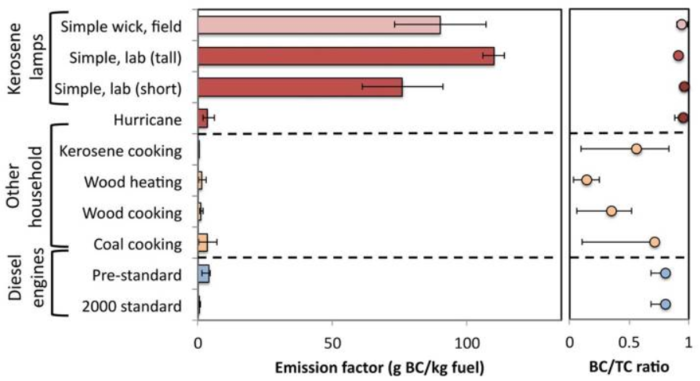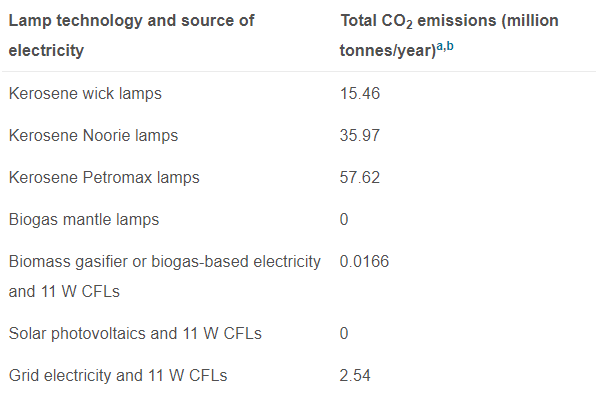Knowledge fuels change - Support energypedia!
For over 10 years, energypedia has been connecting energy experts around the world — helping them share knowledge, learn from each other, and accelerate the global energy transition.
Today, we ask for your support to keep this platform free and accessible to all.
Even a small contribution makes a big difference! If just 10–20% of our 60,000+ monthly visitors donated the equivalent of a cup of coffee — €5 — Energypedia would be fully funded for a whole year.
Is the knowledge you’ve gained through Energypedia this year worth €5 or more?
Your donation keeps the platform running, helps us create new knowledge products, and contributes directly to achieving SDG 7.
Thank you for your support, your donation, big or small, truly matters!
The Reduction of Kerosene Lamp Emissions through Solar Lighting
Overview
Up to date off-grid solar devices have saturated around 17% of the global potential market. These solar devices provide improved access to lighting and energy replacing baseline technologies such as kerosene lanterns, candles or battery lights (Global Off-Grid Lighting Association, 2018).[1] Non-electrified areas still widely rely on such baseline technologies for lighting especially on kerosene (see Markets for Kerosene Lamps). However, burning of kerosene emits pollutants that are not only harmful to the health of the household members, but also contribute to greenhouse gases (GHG). Renewable energy technologies such as solar lamps could make it possible to prevent these negative impacts and improve health and living conditions for people without energy access. In the following the emissions caused by kerosene lamps and their negative health impacts are explained. Then, the potential of emission reduction through the use of solar lamps is examined.
Kerosene Lamps
Kerosene lamps and candles are still widely used for lighting purposes in non-electrified areas. However, these light sources only provide poor illumination and in addition, generate harmful emissions to humans and the environment (Barron and Torero, 2017).[2]
Emissions from Kerosene Lamps
Devices fuelled with kerosene can emit high amounts of fine particulate matter, carbon monoxide, nitric oxides and sulphur dioxide (Baurzhan and Jenkins, 2016; Lam et al., 2012b).[3][4] These pollutants accumulate in the living spaces of the households where kerosene lamps are used. Also, research shows that the concentrations of fine particulate matter (PM 2.5) in households can rise above the World Health Organisation’s recommended values through the use of kerosene lamps (Barron and Torero, 2017; Lam et al., 2012a).[2][5]
The pollution from kerosene lamps and candles used for lighting by rural households contributes to greenhouse gas (GHG) emissions as well. Commonly accepted estimates state: for every litre of kerosene burnt, 2.5kg of CO2 are released into the atmosphere. Different studies indicate a monthly consumption of 3 – 30 litres of kerosene use per household for lighting (Lighting Africa, 2010).[6] In comparison to GHGs emitted by household cooking, however, the volume of GHG emissions from candles and kerosene lamps is relatively small (Baurzhan and Jenkins, 2016).[3] Yet, in addition to CO2, kerosene lamps produce black carbon during combustion, increasing their contribution to GHGs considerably. Whereby the type of kerosene lamp plays a significant role in the amount of black carbon emitted (Tedsen, 2013).[7] A study in 2012 exposed that 7-9% of kerosene burnt by the commonly used simple wick lamp is transformed to nearly pure black carbon (Lam et al., 2012a).[5] The following Figure 2 displays the different emission factors for black carbon and the varying black carbon to aerosol carbon ratios of different kerosene lamps, household appliances and diesel engines.
It can be noticed that the simpler the lamp is the more particulate matter is emitted. This is due to the fact that the flame in the lamp is not shielded from ventilation and therefore the combustion is less efficient. Locally manufactured simple wick lamps account for a large percentage of kerosene lamps (Apple et al., 2010).[8] Therefore, great potential in significantly reducing GHG emissions by replacing fossil fuel lighting such as kerosene through electrification or other technologies (battery-powered LEDs and) exists. (see Off-grid Lighting Transition from Kerosene to LED)
Health Impacts of Kerosene Lamps
The emissions produced during the combustion of kerosene can harm lung function as well as increase asthma, cancer risks and infectious illness. In addition, liquid kerosene fuel potentially poses health risks prior to the combustion process as opposed to biomass fuels. Further, hazards such as fires, explosions and poisonings induced by kerosene are possible (Apple et al., 2010; Lam et al., 2012b).[8][4]
Kerosene lamps are more strongly correlated with tuberculosis than kerosene stoves, possibly because lamps burn longer and are kept closer to people than stoves (Pokhrel et al., 2010).[9]
Locally manufactured lamps often contain lead and thus, burning these for several hours indoors releases toxic lead concentrations that harm foetuses and impair children’s mental health development (IOB, 2013).[10] Further impacts of kerosene use on foetal and infant health such as stillbirth have been pointed out by Lakshmi et al. (2013).[11]
The harmful health impacts of using kerosene lamps on a daily basis are plenty and severe and thus, an alternative is urgently needed.
Solar Lighting
Benefits of Use of Solar Products
Solar products enable households to use electric lamps instead of using other conventional lighting methods. This leads to better lighting quality, providing a pleasant environment for working and studying and improved indoor air quality at home (Komatsu et al., 2011a).[12]
Emission Reduction Through Solar Products
There is great potential for improvement of indoor air quality and general CO2 mitigation by replacing kerosene lamps with either renewable energy-based lighting systems or grid-based electricity systems (Mahapatra et al., 2009).[13] Whereby renewable energy-based lighting systems such as solar lanterns or even Solar Home Systems (SHS) obviously emit even less CO2 than lighting systems powered by the grid.
Several studies have demonstrated that households using lighting powered by solar PV technologies such as Solar Home Systems (SHS) consume less kerosene (Barman et al., 2017; Komatsu et al., 2011a)[14][12] which consequently leads to less harmful emissions being produced. In addition, solar technologies can relieve the risk of indoor air pollution by avoiding the negative impacts of kerosene (Obeng et al., 2008; Pode, 2010).[15] Regarding the consumer side, households take health aspects into consideration when deciding to acquire solar PV systems, a study in Bangladesh showed. Especially concerning the size of a SHS, intentions for health risk reduction had a great impact on the purchasing decision (Komatsu et al., 2011b).[16] Another study in India reported that 56% of the interviewed SHS users stated that the health of women improved after replacing kerosene lamps with lighting powered by SHS. Furthermore, other health related issues such as eye problems, headache and coughing had reduced (Barman et al., 2017).[14]
The table displays the amount of annual CO2 emissions from various lighting systems used in India in the year 2001. Whereby, biogas-, biomass-, solar photovoltaic- and grid electricity-based lighting systems are operated with compact fluorescent lamps. Clearly the CO2 emissions emitted by kerosene lamps depend on the type and quality of the lamp and are the largest amount of emissions of all examined lighting systems. On the other hand, solar PV and biogas mantle lamps do not cause any CO2 emissions.
Recent 2018 estimations of GOGLA state that 22.8 million kerosene lanterns have been replaced with solar lighting (Lighting Global quality verified products) and thus, 51 million metric tons of black carbon and CO2 have been avoided cumulatively over the expected lifetime of the products so far (Global Off-Grid Lighting Association, 2018).[1] This proves that replacing kerosene lamps with solar lamps would decrease a large amount of CO2 emissions.
Regarding the emission levels in living spaces caused by lighting the graph below (Figure 3) shows the range of PM2.5 levels found in different living spaces using different lighting devices.
Clearly, the living rooms in which solar lamps are used for lighting have the lowest concentration of PM2.5 and almost all registered results lie below the WHO guideline level for acceptable indoor PM 2.5 concentrations within 24 hours. The high PM2.5 levels in the kitchens can be explained by the use of solid fuels for cooking. Further, this study showed that only 27.6% of households that were using kerosene wick lamps met WHO indoor air quality standards, whereas 75% of homes that stated they were using solar lamps met WHO standards (Muyanja et al., 2017).[17]
Various studies have been carried out examining the effect of electrification – either through the grid or off-grid technologies i.e. SHS – and indoor air pollution reduction. Showing that electrification impacts indoor air quality positively (Barman et al., 2017; Komatsu et al., 2011a, 2011b).[14][12][16] However, the correlation between the use of solar lamps in particular and the improvement of air quality and emission reduction has not been examined sufficiently.
Conclusion
The replacement of kerosene lighting by lighting through solar technologies can reduce a large amount of emissions as well as improve the indoor air quality of households. Households using kerosene lamps suffer from traceable health impacts from the pollutants being emitted.
- CO2 emission reduction potential: approx. 110 million tonnes CO2/ year (in case of replacement of all kerosene lamps with solar)
- Indoor Air Quality: Improvements for two thirds of population currently using on kerosene lamps.
However, further research is still necessary to examine the correlation of emission reduction on household level and solar lamps. Majority of the evidence of improved health conditions rests on consumer surveys and thus, the consumer perception. Few studies have been carried out in the field and current scientific findings on the reduction of pollutants in the air are based on controlled laboratory tests. With regard to “New Policies Scenario” predictions of the International Energy Agency (IEA) in 2030 an estimated 675 million people in South of the Sahara Africa (SSA) alone will continue to not have access to electricity (International Energy Agency, 2017).[18] Thus, if solar lamps and other off-grid renewable energy technologies will not be widely improved, disseminated and adopted in the near future, SSA and other regions in the world will most likely still heavily rely on kerosene for lighting which would continue to impact the population’s health negatively and emit harmful CO2. Solar lamps and other off-grid renewable energy technologies are capable of improving indoor air quality and reducing emissions produced. To what extent however, still needs to be examined in detail.
Further information
- For further information on solar PV technologies please see: Solar Portal
- Further information on lighting needs in developing countries and improved lighting
- Further information on Indoor Air Pollution (IAP)
- Kerosene lighting contributes to household air pollution in rural Uganda
- Further information on the impact of PicoPV products on the candle and kerosene lamp market
- Further information on the off-grid lighting transition from kerosene to LED
References
- ↑ 1.0 1.1 Global Off-Grid Lighting Association, 2018. Global Off-Grid Solar Market Report - Semi-Annual Sales and Impact Data.
- ↑ 2.0 2.1 Barron, M., Torero, M., 2017. Household electrification and indoor air pollution. J. Environ. Econ. Manag. 86, 81–92. https://doi.org/10.1016/j.jeem.2017.07.007
- ↑ 3.0 3.1 Baurzhan, S., Jenkins, G.P., 2016. Off-grid solar PV: Is it an affordable or appropriate solution for rural electrification in Sub-Saharan African countries? Renew. Sustain. Energy Rev. 60, 1405–1418. https://doi.org/10.1016/j.rser.2016.03.016
- ↑ 4.0 4.1 Lam, N.L., Smith, K.R., Gauthier, A., Bates, M.N., 2012b. Kerosene: A Review of Household Uses and their Hazards in Low- and Middle-Income Countries. J. Toxicol. Environ. Health Part B 15, 396–432. https://doi.org/10.1080/10937404.2012.710134
- ↑ 5.0 5.1 Lam, N.L., Chen, Y., Weyant, C., Venkataraman, C., Sadavarte, P., Johnson, M.A., Smith, K.R., Brem, B.T., Arineitwe, J., Ellis, J.E., Bond, T.C., 2012a. Household Light Makes Global Heat: High Black Carbon Emissions From Kerosene Wick Lamps. Environ. Sci. Technol. 46, 13531–13538. https://doi.org/10.1021/es302697h
- ↑ Lighting Africa, 2010. Solar Lighting for the Base of the Pyramid - Overview of an Emerging Market -.
- ↑ Tedsen, E., 2013. Black Carbon Emissions from Kerosene Lamps. Ecol. Inst. Berl.
- ↑ 8.0 8.1 Apple, J., Vicente, R., Yarberry, A., Lohse, N., Mills, E., Jacobson, A., Poppendieck, D., 2010. Characterization of particulate matter size distributions and indoor concentrations from kerosene and diesel lamps: Indoor particulate matter concentrations from kerosene lamps. Indoor Air 20, 399–411. https://doi.org/10.1111/j.1600-0668.2010.00664.x
- ↑ Pokhrel, A.K., Bates, M.N., Verma, S.C., Joshi, H.S., Sreeramareddy, C.T., Smith, K.R., 2010. Tuberculosis and Indoor Biomass and Kerosene Use in Nepal: A Case–Control Study. Environ. Health Perspect. 118, 558–564. https://doi.org/10.1289/ehp.0901032
- ↑ IOB, 2013. Renewable energy: access and impact: a systematic literature review of the impact on livelihoods of interventions providing access to renewable energy in developing countries. Ministry of Foreign Affairs of the Netherlands, Policy and Operations Evaluation Department (IOB), The Hague.
- ↑ Lakshmi, P.V.M., Virdi, N.K., Sharma, A., Tripathy, J.P., Smith, K.R., Bates, M.N., Kumar, R., 2013. Household air pollution and stillbirths in India: Analysis of the DLHS-II National Survey. Environ. Res. 121, 17–22. https://doi.org/10.1016/j.envres.2012.12.004
- ↑ 12.0 12.1 12.2 Komatsu, S., Kaneko, S., Ghosh, P.P., 2011a. Are micro-benefits negligible? The implications of the rapid expansion of Solar Home Systems (SHS) in rural Bangladesh for sustainable development. Energy Policy 39, 4022–4031. https://doi.org/10.1016/j.enpol.2010.11.022
- ↑ Mahapatra, S., Chanakya, H.N., Dasappa, S., 2009. Evaluation of various energy devices for domestic lighting in India: Technology, economics and CO2 emissions. Energy Sustain. Dev. 13, 271–279. https://doi.org/10.1016/j.esd.2009.10.005
- ↑ 14.0 14.1 14.2 Barman, M., Mahapatra, S., Palit, D., Chaudhury, M.K., 2017. Performance and impact evaluation of solar home lighting systems on the rural livelihood in Assam, India. Energy Sustain. Dev. 38, 10–20. https://doi.org/10.1016/j.esd.2017.02.004
- ↑ Obeng, G.Y., Akuffo, F.O., Braimah, I., Evers, H.-D., Mensah, E., 2008. Impact of solar photovoltaic lighting on indoor air smoke in off-grid rural Ghana. Energy Sustain. Dev. 12, 55–61. https://doi.org/10.1016/S0973-0826(08)60419-6
- ↑ 16.0 16.1 Komatsu, S., Kaneko, S., Shrestha, R.M., Ghosh, P.P., 2011b. Nonincome factors behind the purchase decisions of solar home systems in rural Bangladesh. Energy Sustain. Dev. 15, 284–292. https://doi.org/10.1016/j.esd.2011.03.003
- ↑ Muyanja, D., Allen, J.G., Vallarino, J., Valeri, L., Kakuhikire, B., Bangsberg, D.R., Christiani, D.C., Tsai, A.C., Lai, P.S., 2017. Kerosene lighting contributes to household air pollution in rural Uganda. Indoor Air 27, 1022–1029. https://doi.org/10.1111/ina.12377
- ↑ International Energy Agency, 2017. World Energy Outlook 2017. OECD/IEA.























